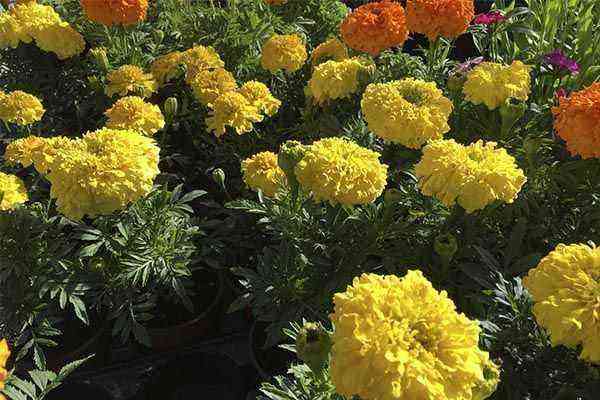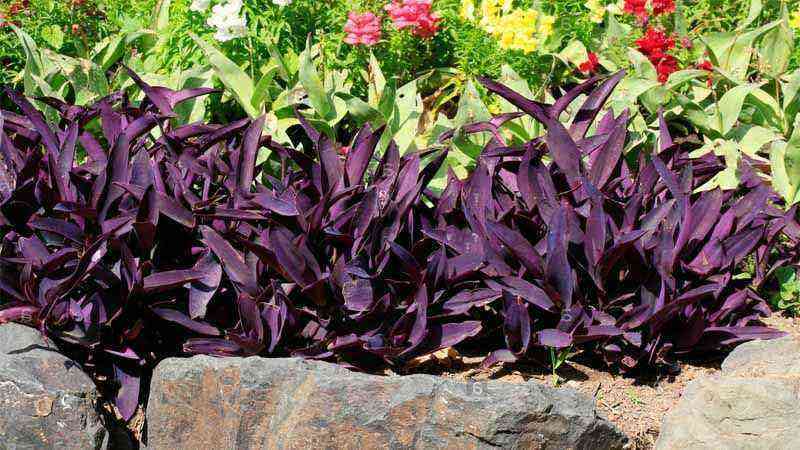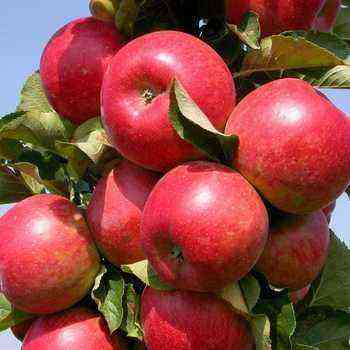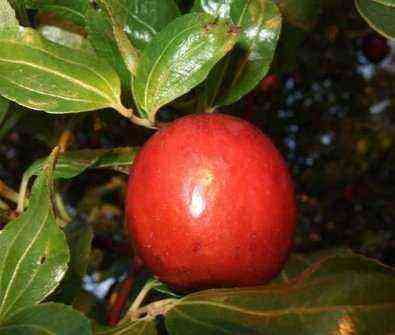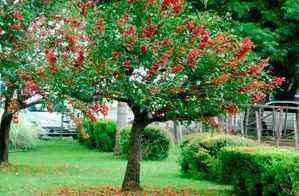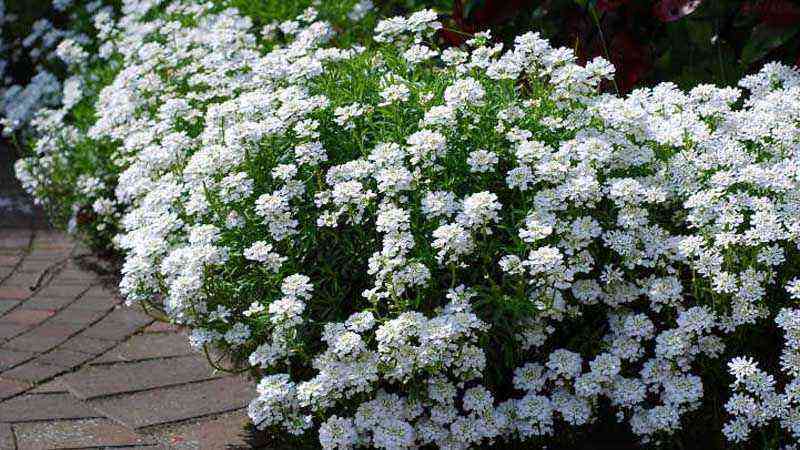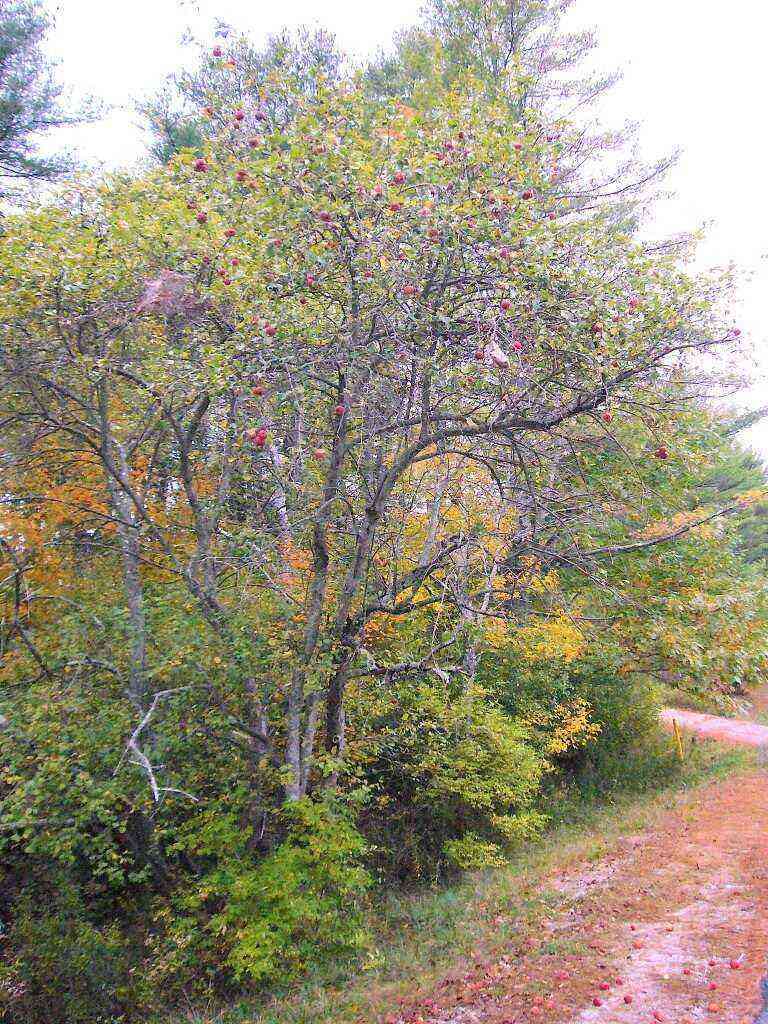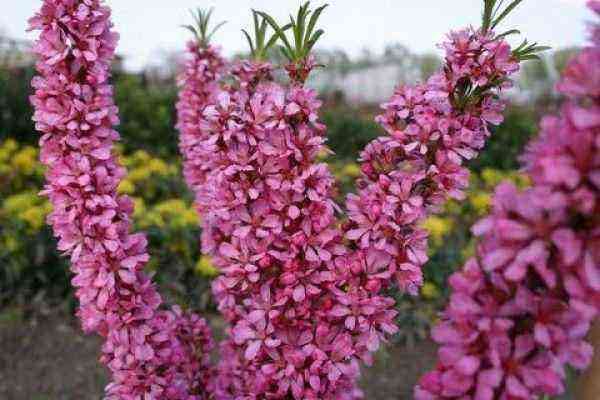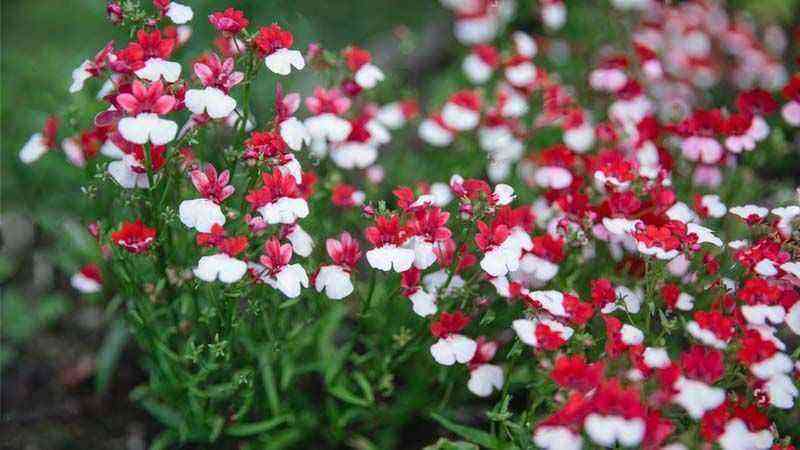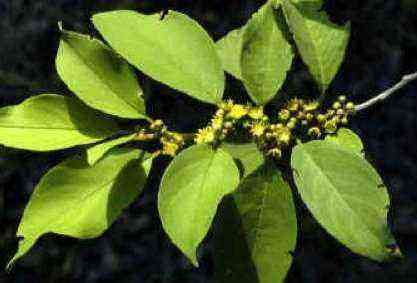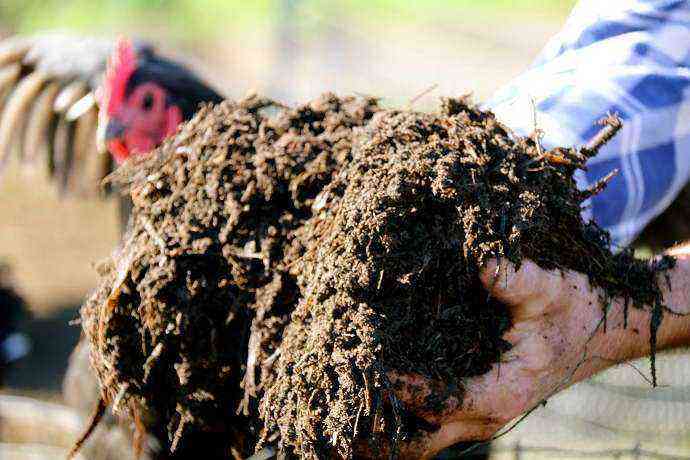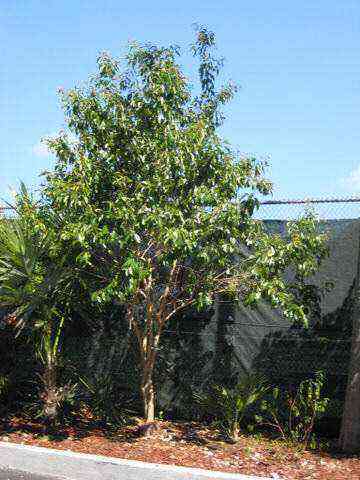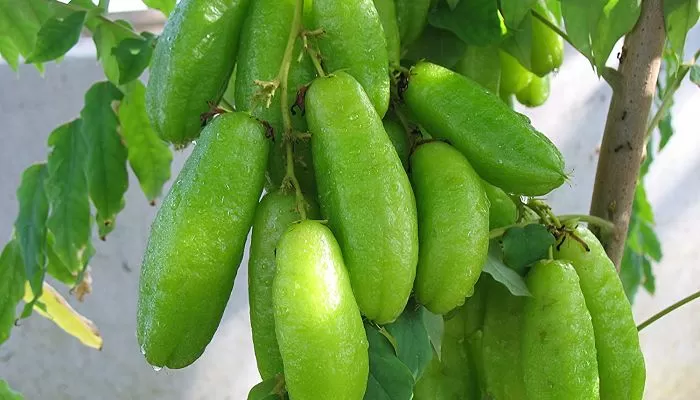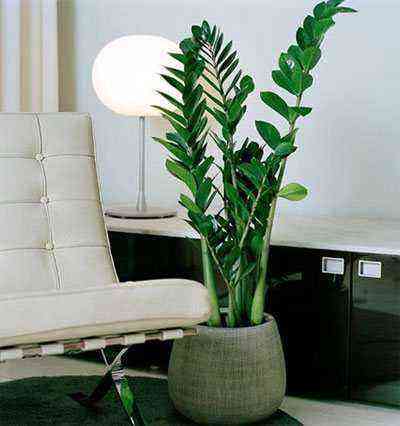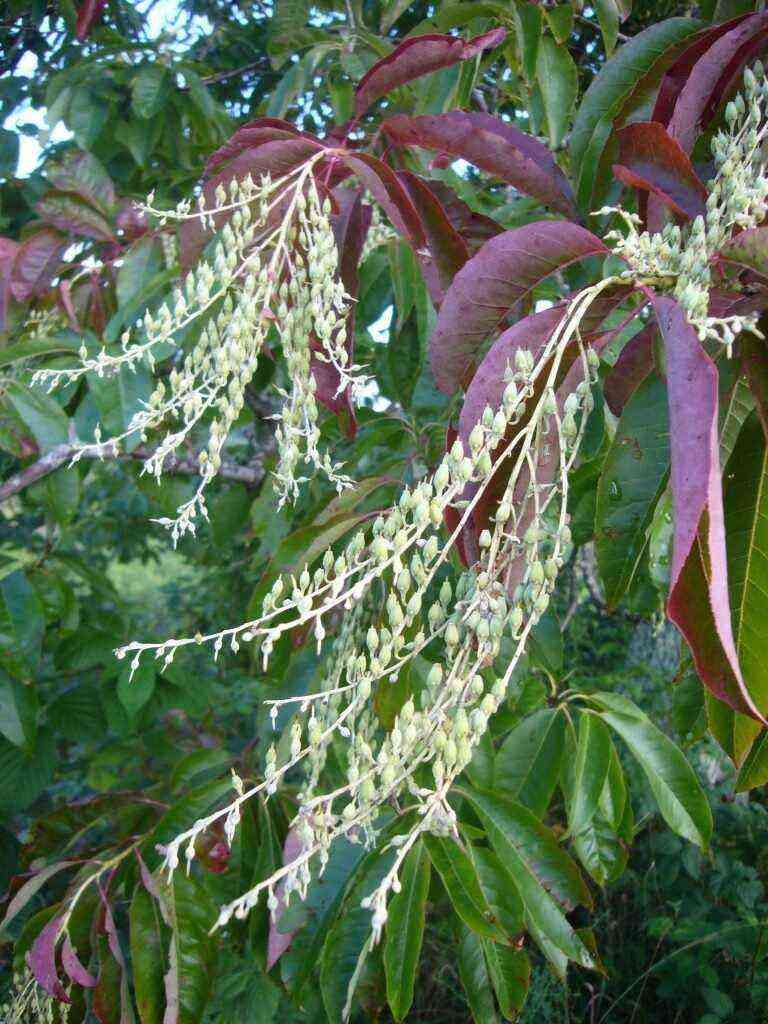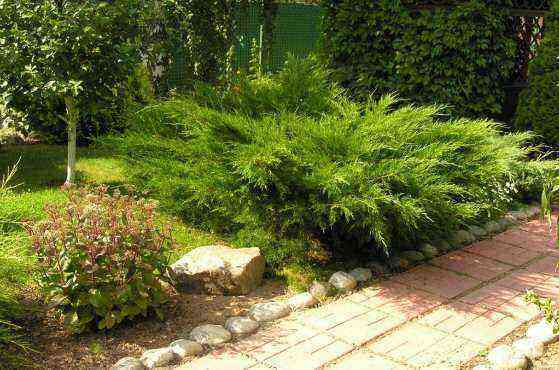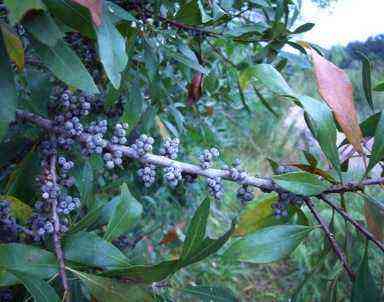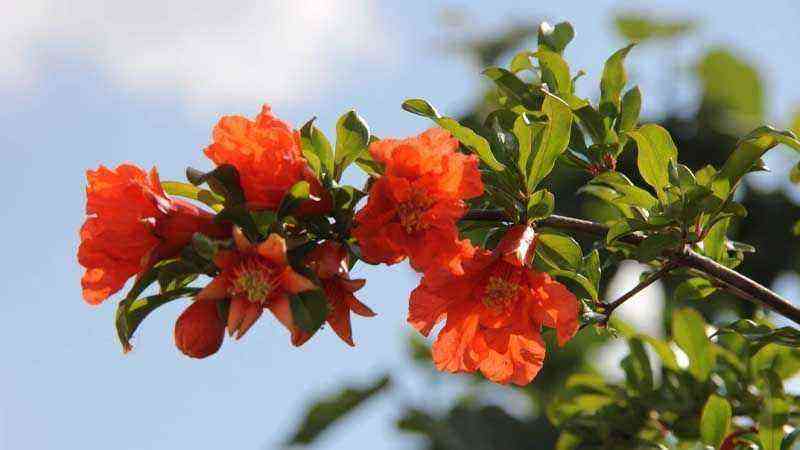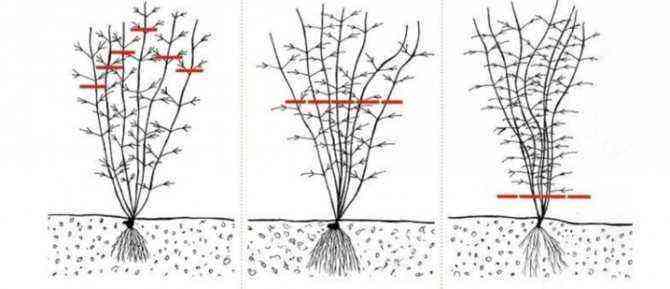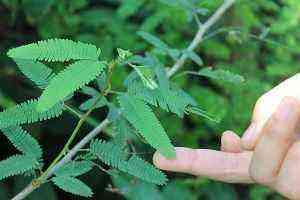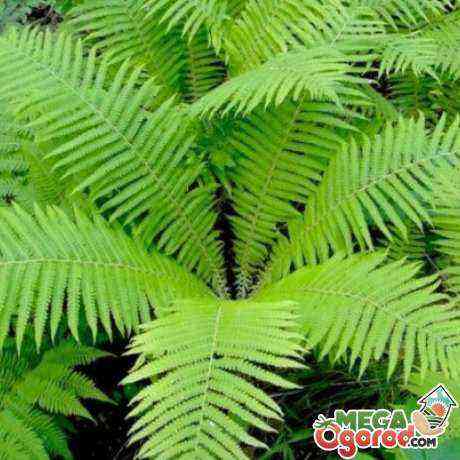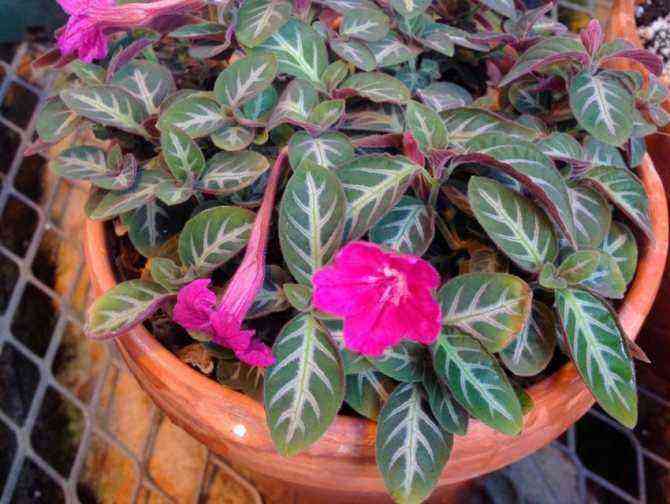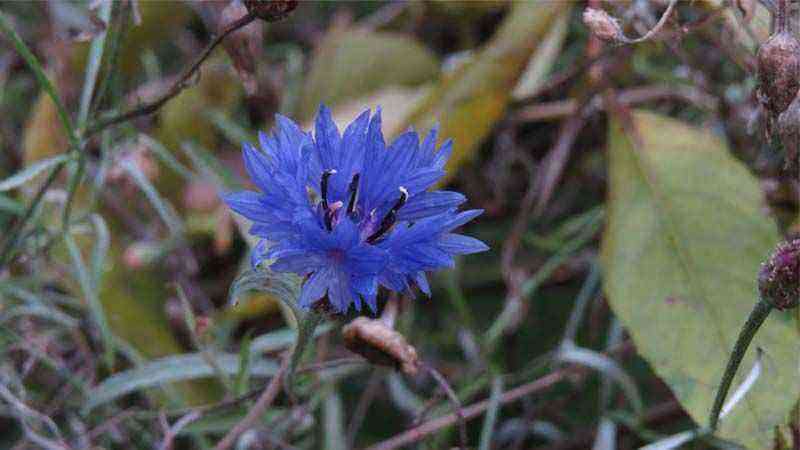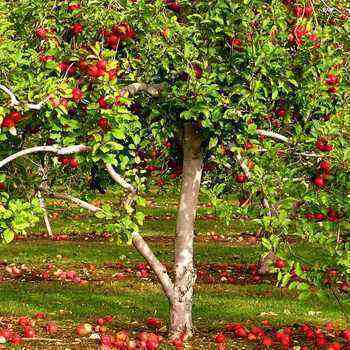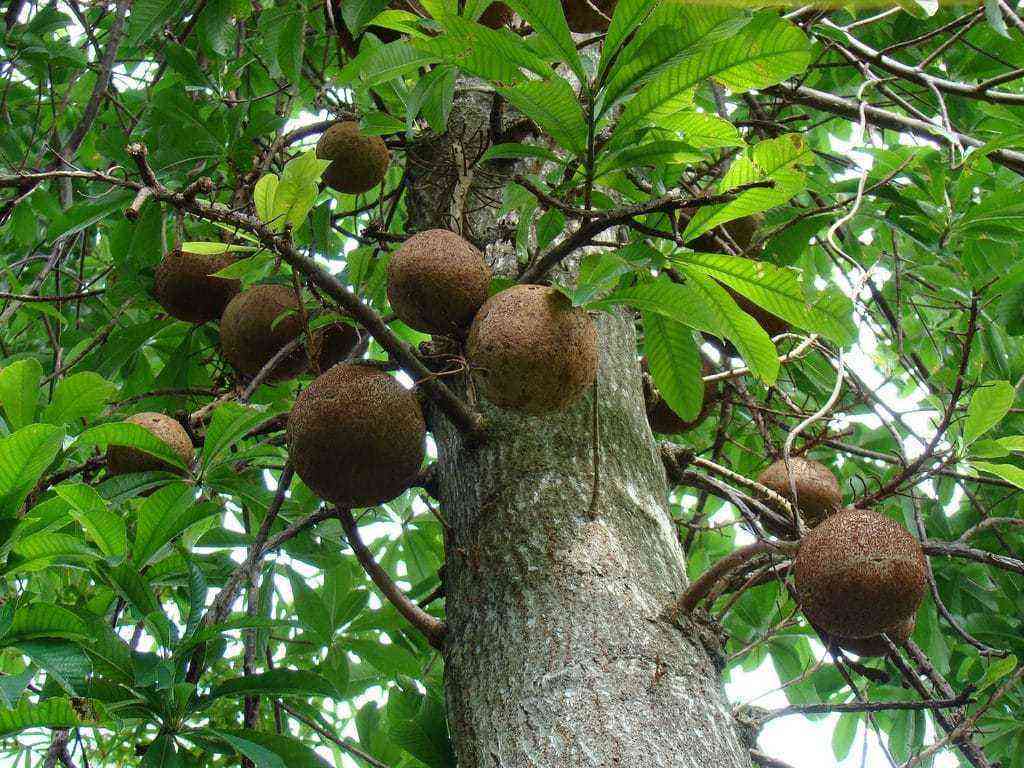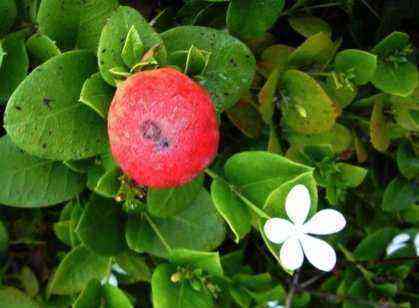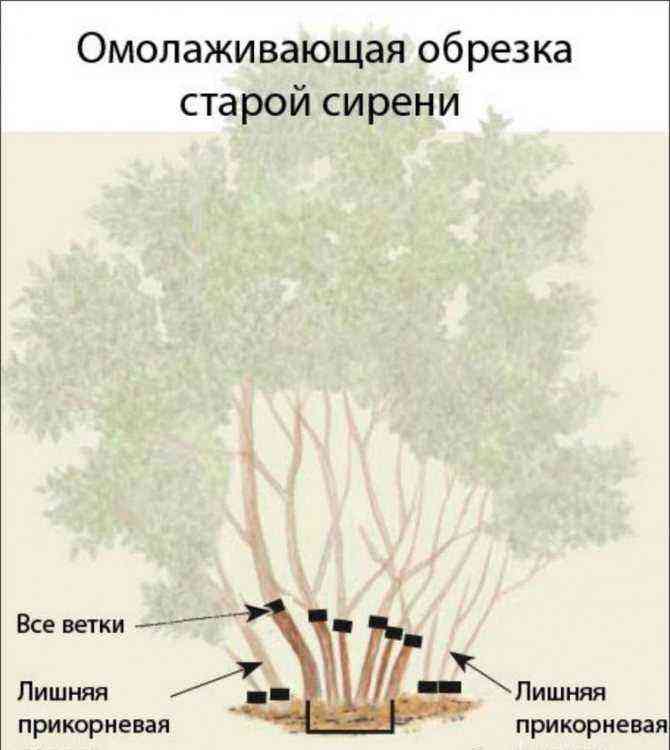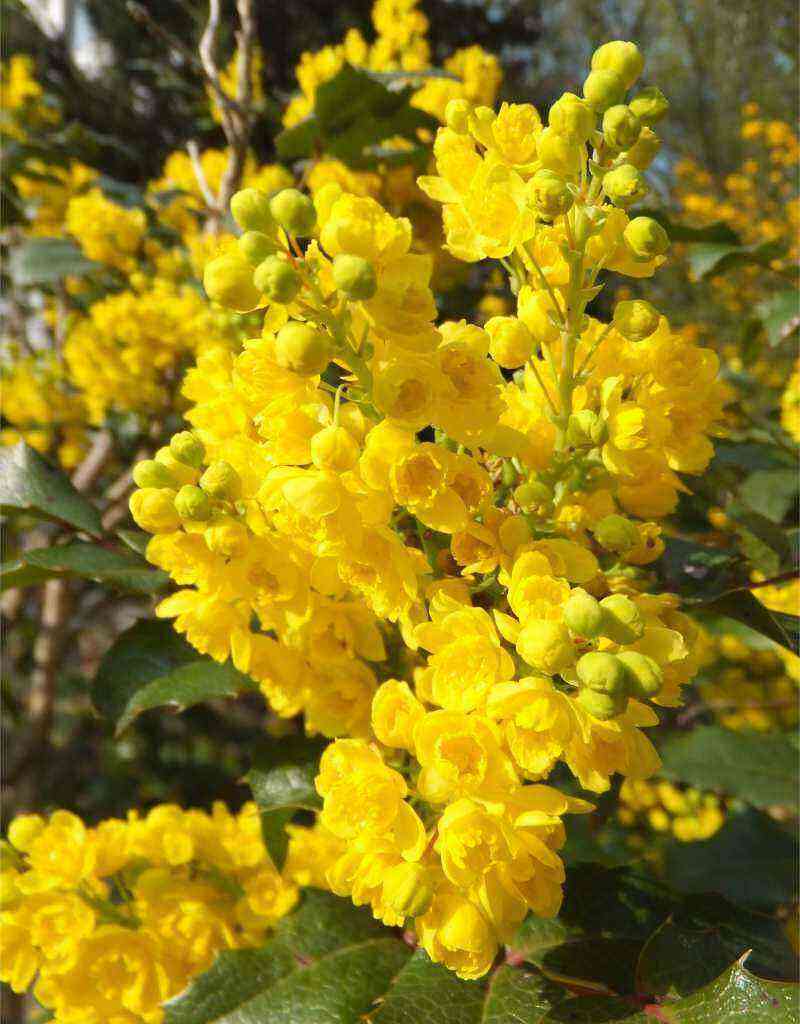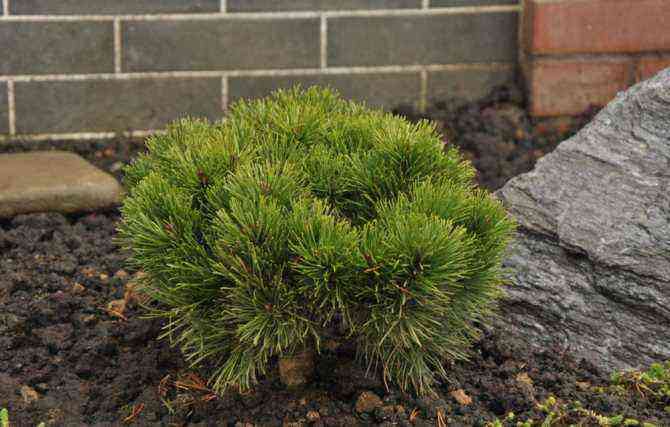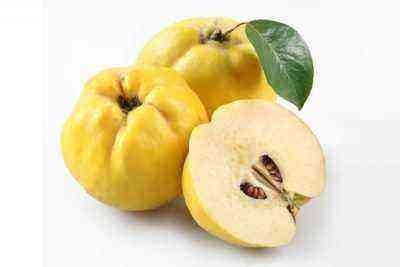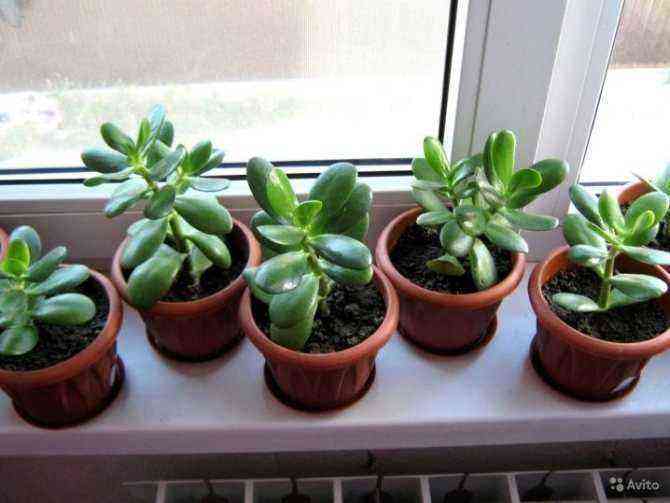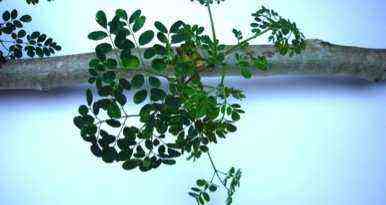Main characteristics
This type of shrub spreads along the ground and does not exceed 50 cm in height. Its main feature is its beautiful leaves, the color of which differs in different varieties. It is unpretentious in care, and has intensive growth in width. Many variegated shrubs love a lot of light and euonymus is no exception.
The euonymus shrub bears fruit, but in our climatic conditions it is rare. The fruits look attractive, but not as beautiful as those of other species. You cannot eat them because they are poisonous.
How the European red cascade euonymus grows
European red cascade spindle tree is found throughout Europe in mixed forests.
The main characteristics of this species:
- It can grow in shrubs and trees, in a bush it can reach 3 meters in height, but if a tree, it reaches a height of 6 meters and at the same time has a crown 5 meters in diameter;
- Resistant to frost and grows quickly;
- In the fall, throws off the foliage;
- It has a shallow but branched root;
- The leaves are of the usual shape, which is no different from the foliage of an ordinary tree;
- Such a tree blooms in May, it has small flowers that are collected in an umbrella;
- Bears fruit, but not with ordinary fruits, they are in the form of a box, which has 4 valves;
- The wood of this tree is hard, so it is used for making small objects, for example, for making knitting needles and spindles.
European euonymus does not need extra care. For such a plant, the main thing is high-quality pruning, optimal watering and periodic fertilization.
The appearance of the euonymus and its life in nature
The Bereskletov family contains about two hundred plants. They can be seen in almost all corners of the globe, excluding the extreme north. Wild representatives of euonymus settled in forests in temperate and subtropical climates, some, but their minority, settled in the tropics. 20 varieties grow on the territory of Russia.


Sahilinsky spindle tree in autumn fiery bright
Euonymus is a plant that is evergreen or sheds leaves in the fall. It can be an upright or creeping branchy shrub, miniature or large, tree about 5 meters. Adult shoots of spindle tree are covered with bark, and sometimes with wart growths. The section of branches in different species is very different, except for the usual – rounded, there is a tetrahedral.
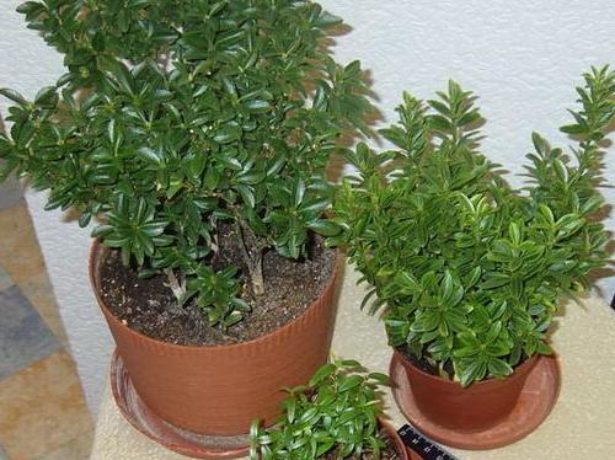
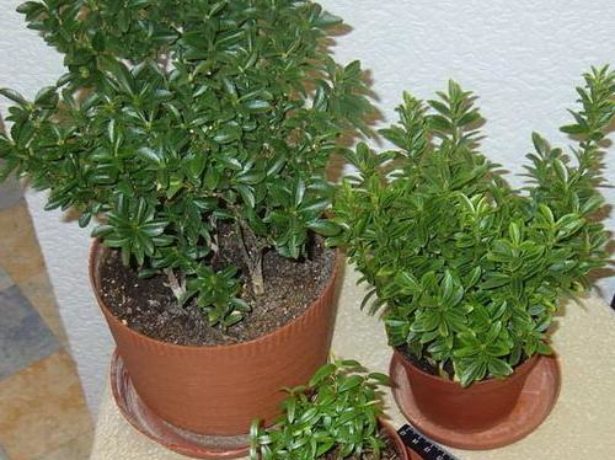
Even a green euonymus looks very decorative.
The foliage of the euonymus is harsh, leathery, glossy, egg-shaped, the size varies from 2 to 5 cm. The color is from dark green to pale. In horticulture and floriculture, forms with colored foliage are common. Spots and strokes of whitish, yellow or cream color are scattered on the leaf.

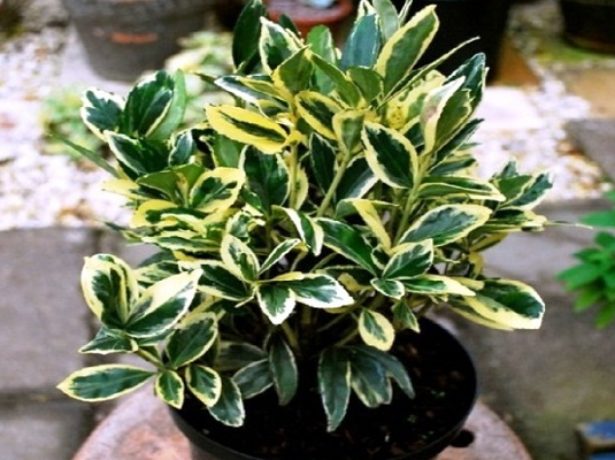
Euonymus is prized for its motley leathery foliage
Euonymus, which lives at home, blooms extremely rarely. And bushes and trees growing in the wild usually bloom in May. The plant does not become more beautiful from this.
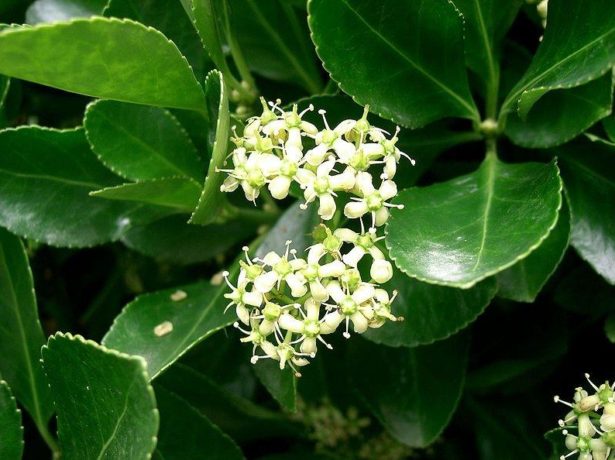
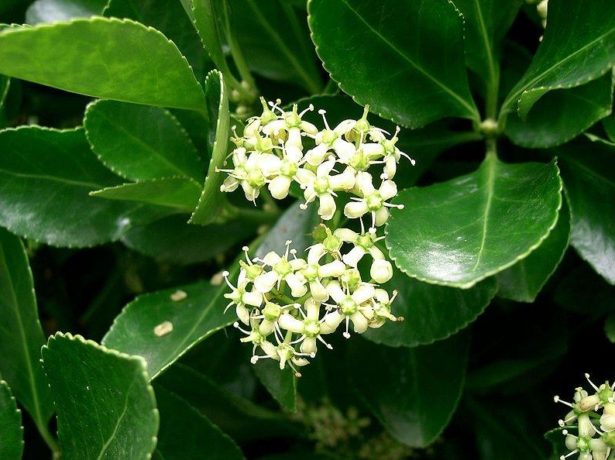
In spring, brushes of small flowers appear on the euonymus
Harvest fresh and healthy mushrooms all year round!
“Home mycelium” – these are natural mushrooms with a quality guarantee. More than 5 kg of fresh and low-calorie mushrooms from one set
Learn more
Small inflorescences, whitish or yellow-green, are collected in drooping clusters and often smell unpleasant. And the fruits of euonymus, they ripen in early autumn, are very attractive.
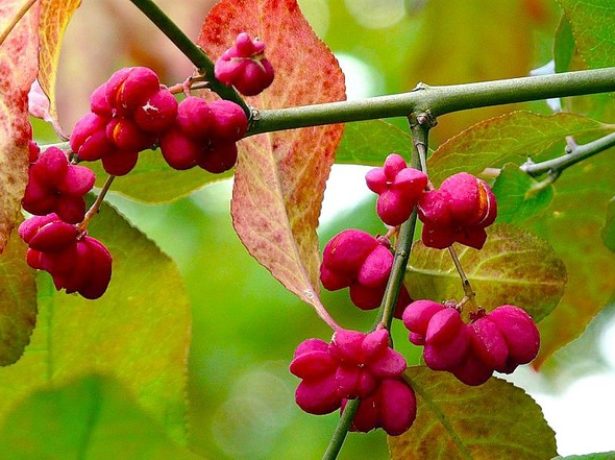
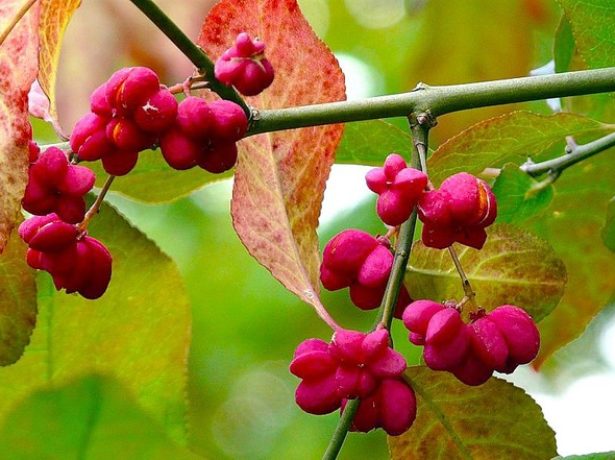
Euonymus fruits are very attractive, but insidious, they contain poison
On thin peduncles, colorful boxes of incredible shape hang down. They can be scarlet, purple, burgundy-purple in color, with wings or thorns. But this appearance is deceiving – the fruits of the euonymus are poisonous, like all parts of the plant.
Evergreen trees or bushes of extraordinary color with no less amazing round shoots. Leaves are usually smooth, smooth with variegated color.
Nondescript flowers during the flowering period transform from greenish to brown and bloom after the leaves unfold.
A prickly box with red or blackish seeds with a burgundy prunus is the fruit. As they ripen, the pale green boxes turn bright red to ruby color, resembling lanterns.
The bush is quite contrasting – these are garlands of burgundy “boxes” against the background of green leaves. And when the foliage turns yellow, the capsules crack, forming a “parachute”.
If you look at the photo of the euonymus, you can see how it shimmers with colors unusually beautifully.
The shrub is poisonous, but thanks to cultivation, the plant has become available as an ornamental one. It can often be found as one of the components of a hedge (euonymus shrub) or as a decoration for various buildings, as well as composting sites.
Description of the species
Among the undersized shrubs of euonymus, the winged compactus stands out for its undersized, but lush and spreading crown, as well as its slow growth. Despite its modest size (the height of the euonymus of the compactus rarely exceeds 1 m), the crown can grow up to 3 m in diameter, while it is very dense. The root system of the bush is superficial, with thin branched roots.
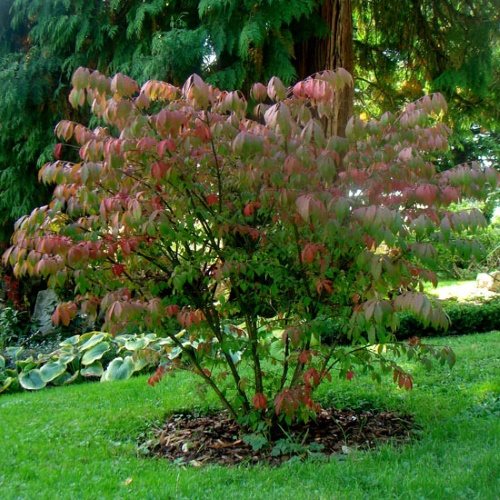
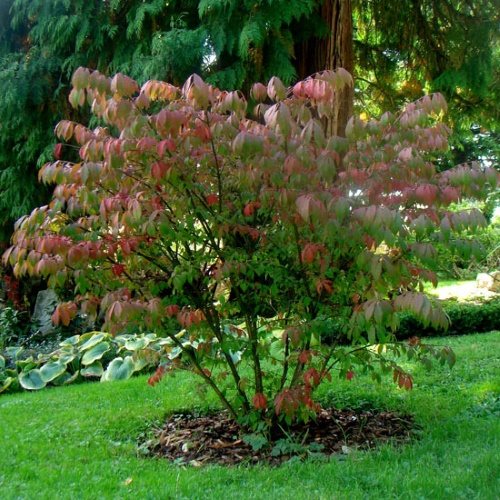
“Winged” euonymus is called because of the interesting shape of the shoots: they consist of four faces, moreover, they are decorated with longitudinal wings.
The shrub is deciduous, and bares its branches for the winter. In the spring, bright green elongated leaves grow on them. With the arrival of autumn, they begin to gradually change color and turn brown, until the entire crown looks like a blazing red ball.
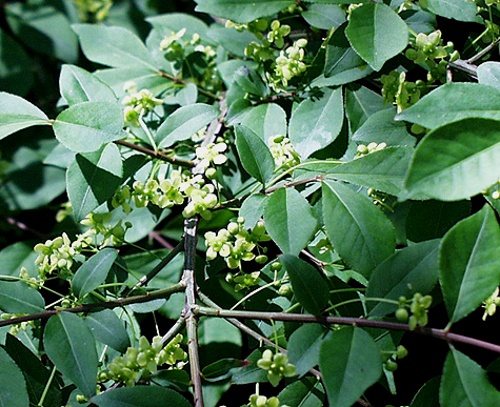
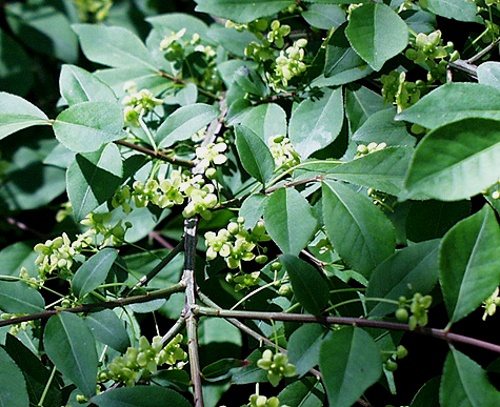
Blossoming of winged euonymus occurs in May, and then white-green small inflorescences bloom among the green foliage. In autumn, in their place, red-orange berries ripen on long petioles. They hang like beautiful earrings on the branches even when all the leaves have already fallen, until the end of winter, for which the euonymus is popularly nicknamed “wolf earrings”.
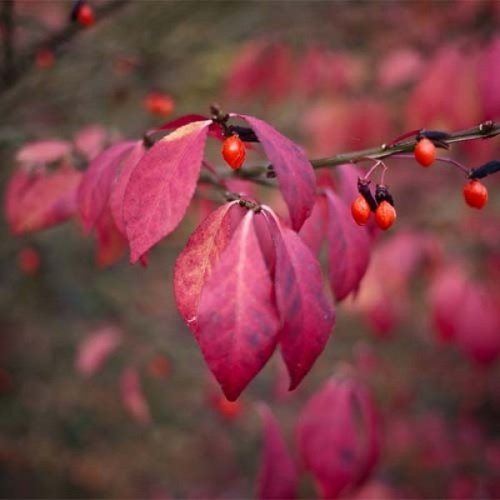
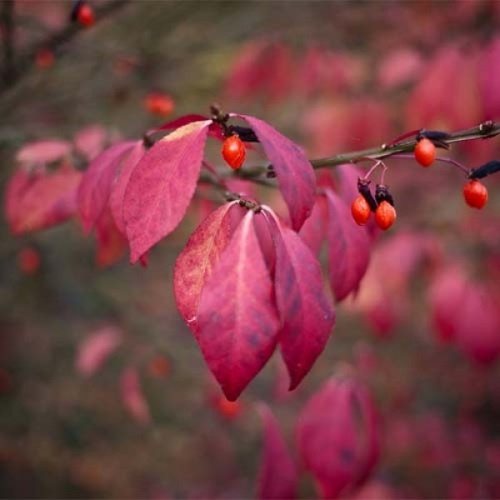
The fruits of spindle tree are not eaten due to their unpleasant taste and the ability to cause vomiting and diarrhea.
How to grow euonymus
In order for the planting of the shrub to be successful, it must be carried out in the spring, but under some conditions this can be done in the fall. The choice of planting site depends on the variety of euonymus, but Fortune’s species loves a lot of light.
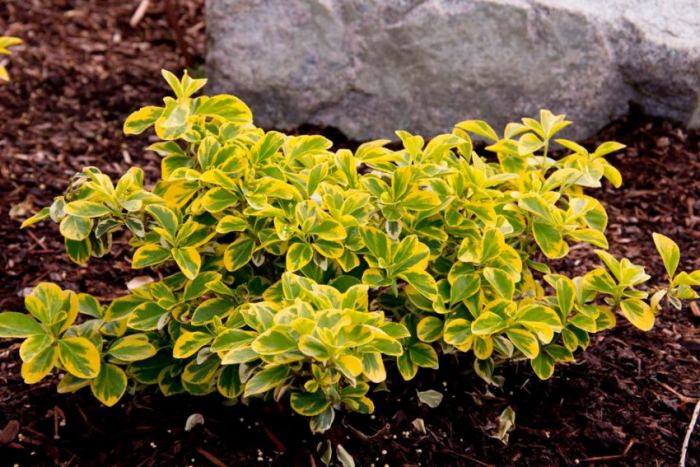
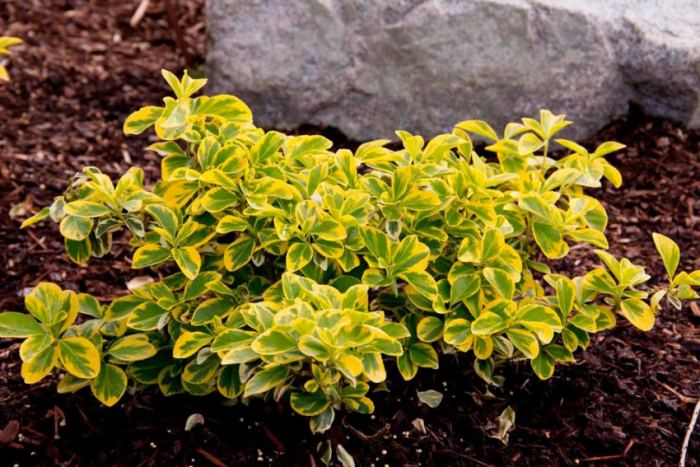
This plant prefers fertile soils such as black soil. If the soil on the garden plot is acidic, then it must be treated with lime. Places where groundwater is close to the surface should be avoided when planting.
The use of winged euonymus in landscape design
Hedge – an example of the use of euonymus in landscape design
Winged euonymus is an unpretentious plant. He tolerates cold well, although he does not like extreme heat. Shade-tolerant and beautiful, euonymus is often used in landscape design.
Due to its small size, it looks great on small garden plots. You can create a hedge from it, plant curbs with it.
Winged euonymus lends lightness to compositions composed of trees and shrubs, and looks spectacular against the background of juniper and pine. He is planted on rocky hills. There it can grow well, rooting with lower branches.
If you plant this plant with ornamental grasses, they will favorably set off its beauty. In urban conditions, the winged euonymus also feels quite tolerable, since it tolerates the presence of gases and smoke in the atmosphere well.
Plant a winged euonymus on your personal plot and, admiring its beauty, you will experience pleasant lightness and tranquility every time. The plant exudes life-affirming power, and it will gladly give you a piece of it if you take good care of it.
Indoor euonymus or pseudolavr: planting and care rules
Euonymus is a plastic, patient and undemanding plant. It perfectly tolerates the most Spartan conditions, and is good at pruning and shaping. Thanks to this, original bonsai are grown from euonymus. If you correctly cut and shape the stalk, you get a chunky mini-tree with a fluffy and variegated crown.
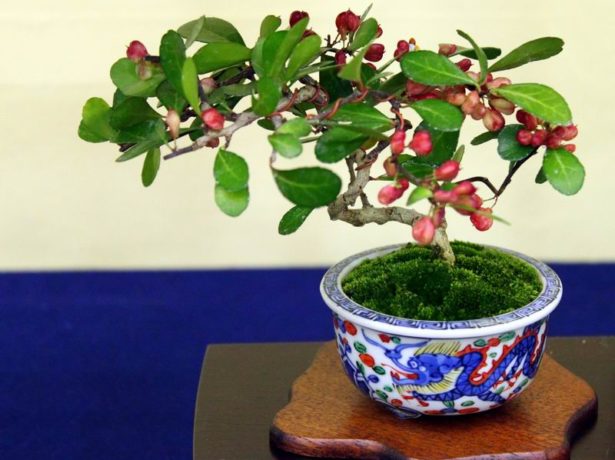
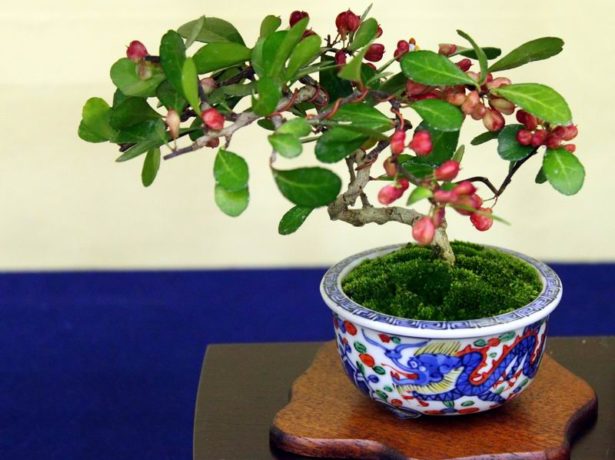
The euonymus is perfectly formed, it can be used to grow bonsai
Remember: euonymus is a poisonous plant, it should not be placed in rooms where children and pets are. The highest concentration of substances hazardous to health is in the fruits of the plant. Don’t try them. 35 fruits is a lethal dose for an adult. Poisoning is manifested by weakness, vomiting, convulsions, cardiac arrhythmias.
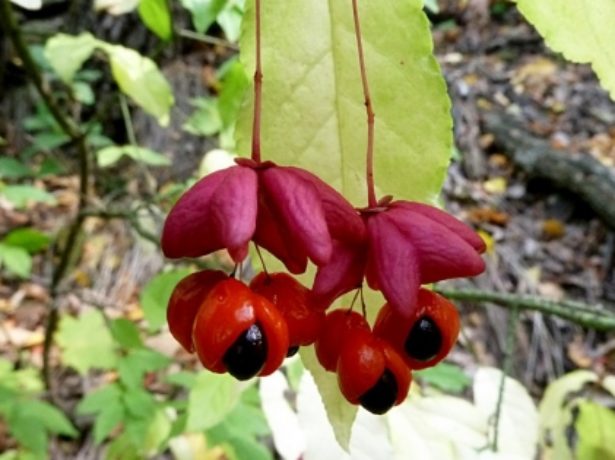
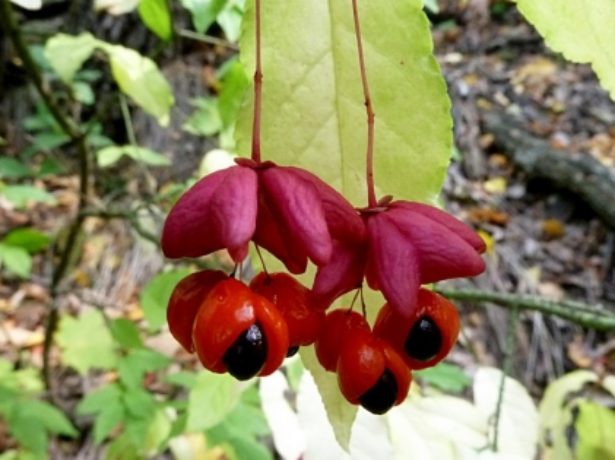
There are many legends and legends about the euonymus
Evergreen euonymus is most often grown as a houseplant: Japanese and rooting (forchuna) – and less often deciduous species: European and winged. Forms that shed their foliage turn red-yellow in autumn, like street trees. They lose leaves, and in the spring they wake up again. Evergreen euonymus can also lose leaves, but this is not the norm, but the result of improper care.
- Japanese euonymus, except for the Land of the Rising Sun, is widespread in Korea and China. This thermophilic plant does not tolerate severe frosts. In the northern countries, including Russia, it is grown only in home and greenhouse conditions. It is a compact, well-leafy shrub. Leaves up to 8 cm long, in the form of an elongated oval, along the edge with small notches. There are evenly colored and variegated varieties. In clusters of inflorescences, there are two to three dozen tiny (1 cm each) greenish-yellow flowers. Fruit pods are orange or pink. The most popular varieties of Japanese euonymus are: mediopictus – a shrub with yellow-golden leaves with a green edge; latifolius albumarginatus – euonymus with green foliage, decorated with a patterned white border; microfilla is a miniature (up to half a meter) shrub with small (2–2,5 cm) white-green leaves; aureo-marginata is a variety with bright green leaves with a golden edge.
- Rooting euonymus (forchuna) is an evergreen creeping shrub, not higher than 60 cm. At the same time, the length of the branches reaches 3 meters. Its homeland is China, the plant can also be seen in the Crimea and Transcaucasia. The leaves of this euonymus are small (2–6 cm), dense, saturated green. They are small, pointed, egg-shaped. The plant is frost-resistant, it is grown both in open ground and in indoor conditions. Varieties of euonymus forchun differ in leaf color. Gracilis is a variety with leaves of a creamy yellow hue, with age they turn white along the edge, red in the middle. Vegetus is a creeping bush with thick stems, large rounded leaves and yellow fruits. Emerald Gold is a bush with branches about one and a half meters. Small creamy foliage along the edge is painted with bright yellow spots, turns red in autumn.
- Dwarf euonymus is an evergreen upright shrub. Grows up to a meter. Rigid narrowish leaves with a sharp tip and slightly curved edges. This euonymus is often shaped like a bonsai. In nature, it is common in the mountains of the Caucasus, Moldova, China and Romania.
- Warty euonymus, or few-flowered, grows in the countries of Western Europe and in central Russia. This is a two-meter shrub or tree. Its greenish bark is provided with wart growths. The foliage is light green, the flowers are brownish, the fruits are pink-red. In autumn, the leaves turn pink. Warty euonymus is grown as a garden ornamental plant.
- European euonymus is native to mountainous Asia Minor. This bushy tree is no higher than 6 meters. On green young shoots there are longitudinal cork outgrowths, and adult branches are almost black. Leaves are leathery, large, turn red in autumn. Ripe fruits are dark pink with orange. The species easily tolerates drought, frost and polluted air. There are over two dozen decorative forms of this species, including weeping euonymus, aucubal, purple, silver-spotted.
- Winged euonymus settles on rocks and in the mixed forests of the Far East, Sakhalin, Japan and Korea. The branched shrub grows up to 2 meters, the tree is about 4 m. The branches are tetrahedral, the leaves look like a diamond, the fruits are scarlet. There are about 20 shapes and varieties. The most common is compactus. It is a compact dome-shaped shrub. Leaves are soft green in summer, turn red in autumn. The plant is winter-hardy, but does not tolerate drought and heat.
The euonymus shrubs that burn in autumn are an original and easy decoration for both the garden plot and the window sill in the house. But how can a fairly large plant, which, depending on the species and variety, reach 1–9 meters in height, can become a pot culture?
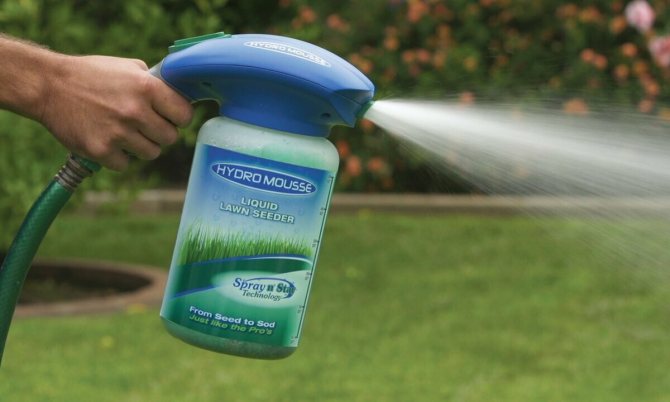
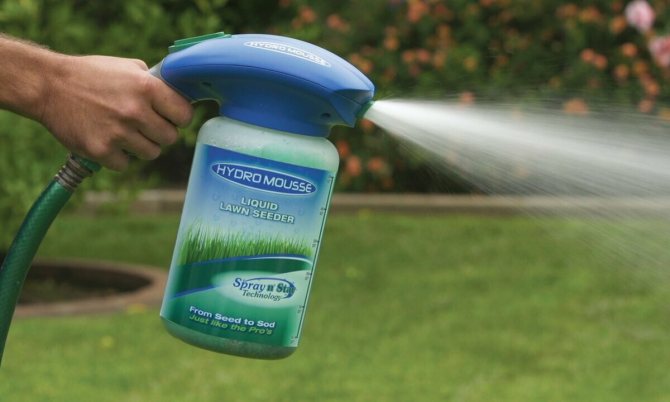
Plant a luscious, vibrant lawn in just 1 hour!
With Hydro Mousse liquid lawn, simply connect the sprayer to a regular garden hose and enjoy a luscious and even lawn.
Details
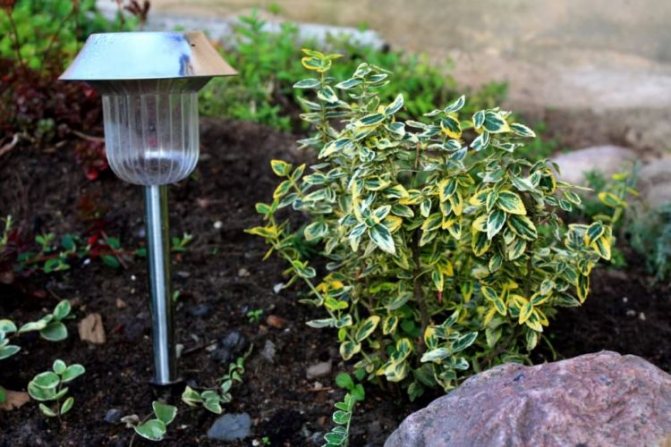

It turns out that euonymus of deciduous and evergreen forms in the East have long been used by bonsai lovers to grow miniature living compositions.
The use of competent pruning and the methodical formation of the crown helps to tame the growth of the indoor euonymus flower. A few years after planting, a real tree with a dumpy trunk, curved branches and a beautiful crown, decorated with foliage and unusual fruits, grows from the cuttings.
For the pot culture, deciduous species are more often chosen, for example, European euonymus or winged euonymus. In this case, scarlet leaves and bright fruit-boxes, as expected, fall off in the fall, and after a period of dormancy with the beginning of spring, the tree wakes up and begins a new growing season.
If the indoor flower is an euonymus of evergreen varieties, for example, Japanese euonymus, then the branches remain covered with red, purple or variegated foliage, but the life processes of the plant slow down, therefore, the care for it also changes.
Planted in a limited volume of a pot, euonymus remains a perennial culture that has its own preferences and characteristics and requires an individual attitude and approach.
How to handle an indoor spindle tree, planting and maintenance of which is carried out not in the open field, but indoors?
Garden euonymus is famous for its good adaptability and unpretentiousness. Even novice lovers of decorative cultures can take care of him.
- The shrub grows well in almost any soil, the main thing is that the substrate is loose and permeable to moisture and air.
- Euonymus of all types tolerate shade well, but you can get a compact, even crown and a bright color of autumn foliage only if the bush is planted in a well-lit place or at least in partial shade.
- Dry air is also not harmful to shrubs, but dry soil can cause wilting of foliage and its premature fall.
- The dormant period lasts from November to April, during the cold season. During these months, the plant needs almost no moisture and nutrients. The illumination of the bush decreases.
The same rules should be adhered to when planting and caring for a room euonymus, as in the photo.
For euonymus, a loose soil with a weak alkaline reaction, an abundance of nutrients and good permeability is required. If the plant is not planned to be subjected to rigid shaping, you can take a mixture of sod land, sand and humus.
For bonsai, it is useful to add loam to the substrate to provide better adhesion of the root system to a small earthy clod.
To limit the growth of the shrub and facilitate the care of the euonymus, planting is carried out in a small-sized pot, the width of which is equal to or greater than the depth. At the bottom of the container, drainage is made to remove moisture unnecessary to the plant and prevent root rot.
After planting spindle tree care includes:
- regular watering when the topsoil is dry under the bush;
- feeding with complex means from April to September with a frequency of 2 times a month;
- spraying the crown of euonymus on especially hot summer days;
- shaping crown pruning before the start of active growing season;
- pinching of lateral shoots appearing in summer;
- sanitary pruning in the fall;
- plant transplant every 3-4 years.
At home, euonymus feels good on western or eastern windows.
It is better to protect the plant from direct sunlight, and if possible, it is best to keep the shrubs in the fresh air from spring until the onset of autumn coolness. Wintering of euonymus is carried out in a cool room. Watering is carried out very sparingly, feeding is not needed.
Indoor flower euonymus can be propagated using seeds collected from ripe and opened bolls, as well as by cuttings.
If the grower has seeds of a suitable variety and quality at his disposal, they are placed in a container with moistened sand and sent to a household refrigerator for three months. Positive temperatures close to zero will harden the planting material and activate pecking.
After the expiration of the period allotted for stratification, the container is removed from the cold and placed in a brightly lit place, previously covered with glass or film to prevent moisture evaporation.
- The heated seeds are transferred to a layer of loose sterilized substrate, laid out on the surface and carefully sprinkled with a thin layer of sand.
- Then the soil is irrigated from a spray bottle.
- A container covered with a film is placed in a greenhouse.
- For the germination of seeds of the indoor euonymus flower, a constant air temperature is required within the range from 22 to 27 ° C.
- Every 4 days, the soil condition is monitored, which, if necessary, is sprayed, and the container with seeds is ventilated.
Botanical description
Euonymus (lat.Euonymus) – a plant from the Bereskletov family, which includes about 190 plant species. Under natural conditions, some species reach a height of 6-7 m, but under indoor conditions, the dimensions of euonymus are much smaller. Representatives of the species can be both trees and shrubs, there are evergreens, and there are deciduous ones. Euonymus are plants that grow well in indoor conditions, do not get sick after transplanting and pruning, if they are carried out on time. They grow well in the shade, so apartments with windows facing north are not an obstacle to the development of the plant. First of all, at home, euonymus are grown as decorative deciduous plants, and in culture the plant usually does not bloom, but it will please with the crown, and depending on the variety, with the color of the leaves. The spindle tree is poisonous, but it is used in medicine, and almost all parts of the plant: seeds, bark, shoots and leaves. The plant has many properties, for example, expectorant, diuretic and anthelmintic. Gutta-percha is obtained from the roots and stems of the plant. In Europe it is European and warty euonymus. When growing euonymus in indoor conditions, Japanese euonymus is most often found.
Proper care
A bush planting hole should be dug a few weeks earlier. Its size should be larger than the root ball of the plant. The earth taken out of the pit is mixed with compost, and the bottom is covered with sand. To get rid of acidic soil, you need to add slaked lime to the hole, about 200 gr. Then mix with humus.
When starting planting, you should straighten the roots, and evenly fill the hole with humus, carefully tamping the ground. This will help to avoid the formation of air gaps. The root collar of the shrub must not be covered; it must be left level with the ground.
If there are enough bushes available, you can plant them in a long trench. Then they can form a hedge on the site. In order for the planting to be successful, it is necessary to water the transplanted bush well for a week.
Watering the Euonymus is necessary as the earth dries out. It is recommended to mulch the soil surface around the shrub, and it will stay moist longer, which will facilitate plant maintenance. You should also loosen the soil around the stem, this will allow moisture to penetrate deeper into the soil, and the root system will be better supplied with oxygen.
Pouring over shrubs is extremely harmful, therefore, in case of frequent rains, manual watering should be excluded. In order for the plant to develop well, it needs to be fed using mineral fertilizers. This procedure is performed twice a year. The first is done in the spring or summer season, the next in the fall. This is how the planting and care of the Euonymus is carried out.
It grows as evergreen or deciduous shrubs, ampelous plants or small trees mainly in temperate climatic zones of Asia, including China and the Himalayas.
Most often, euonymus are grown in the open air in parks and gardens as beautiful, unpretentious and shade-tolerant shrubs.
At home, mainly two compact species are cultivated: Japanese euonymus and rooting euonymus.
The leaves of indoor varieties of euonymus are green or variegated with specks of yellow or cream color. It is in the beauty of the crown and leaves that all the attractiveness of this plant lies.
If pruned correctly, forming a beautiful lush crown, then this plant can become a magnificent exquisite decoration for any home. Flowers of euonymus are nondescript, small, collected in axillary inflorescences.
But the fruits, ripening by autumn, and covered with red, pinkish-brown or orange seed plants, look very decorative. True, at home, euonymus almost never blooms.
Types of euonymus
Japanese spindle tree or Euonymus japonica is a flower intended for indoor cultivation. A sprawling evergreen shrub with beautiful variegated ovoid leaves, with light specks.
Pale green blossoms appear in June, and in autumn the plant’s appearance is revived by ripening capsules with orange seeds. This type has gained great popularity among flower growers due to its unpretentiousness and undemandingness to strict adherence to the temperature regime.
Forchun euonymus or Euonymus fortunei is one of the most winter-hardy species, a creeping shrub with long branches reaching 3 m in the open air, and more than 1 m at home. Looks nice on a support. There are many decorative forms of this variety with variegated white-green leaves.
In recent years, euonymus forchuna has been widely used for landscaping balconies. In summer, it is grown in the open air, in the garden, and with the onset of cold weather it is transferred to glazed balconies, where the temperature can drop below 0 ° C.
For such wintering, it is necessary to insulate the roots of the plant: put foam under the bottom of the pot, mulch the substrate with peat or sawdust, tie the container with batting or burlap.
Spindle tree care at home. Briefly
A spindle tree at home requires the following care:
| Temperature | In summer + 18-20 ° С, in winter + 2-4 ° С. |
| Air humidity | The dense leaves can easily withstand dry air. But when heating is turned on, spraying may be required. |
| Lighting | Bright diffused light without direct sunlight. |
| Watering | As the earthen coma dries. Limited during winter. |
| Ground | A mixture of sod land with humus with the addition of sand or perlite. |
| Top dressing and fertilization | During the period of intensive growth, once every 3-4 weeks with any complex fertilizer for decorative deciduous plants. |
| Spindle tree transplant | As you grow. Usually once a year. |
| Reproduction | Propagated by cuttings with green and semi-lignified shoots. For rooting, use light peat soil or clean sand. |
| Features of growing euonymus. | In winter, the plant needs to create a dormant period at low temperatures. It requires pruning to maintain its shape in spring. |
Transfer
It is recommended to replant the euonymus annually, at the beginning of the growth period – in the spring. For young bushes, this procedure is mandatory, for adults over 5 years old – you can do it after 2-3 years. Euonymus is not capricious in the choice of soil. It develops well even in not very nutritious soil, it is more important that it is porous and light.
- Universal soil for indoor plants.
- Sod, humus and leafy land in a ratio of 2: 1: 1. Be sure to add coarse sand to the mixture.
- Sod land, peat and sand in a ratio of 3: 0,5: 0,5.
However, for the spindle trees, from which the bonsai are formed, the soil should be denser and heavier. Part of the loam should be added to it. So the root system will be better anchored in a small volume of soil.
Choose a container for planting and transplanting a spindle tree not deep, but wide. Its roots are located near the surface, without going deep. For large bushes, it is better to take a ceramic pot, it is more stable and more actively evaporates moisture. If you want the euonymus bush to remain small, limit its growth to the size of the planting container. The more modest the volume of the pot, the slower the plant will develop.


When replanting euonymus, be careful, the plant contains poison
Grows well in clayey soils and sand, with the addition of lime. It is necessary to ensure that the ground around does not dry out too much, because this can destroy the plant.
In the fruiting period, organic and mineral fertilizers are recommended. In general, the soil should be sufficiently rich in micronutrients and well aerated.
With the addition of organic fertilizers (compost, leaf humus), it is produced every year from the beginning of February. Perennial specimens can be replanted less often, accompanied by pruning.
If euonymus is properly grown, then certain varieties can be grown to look like an oak tree up to ten meters high.
It must be remembered that about 35 fruits eaten once can be fatal.
Popular varieties of home plants
Types and varieties of euonymus grown at home (description with photo):
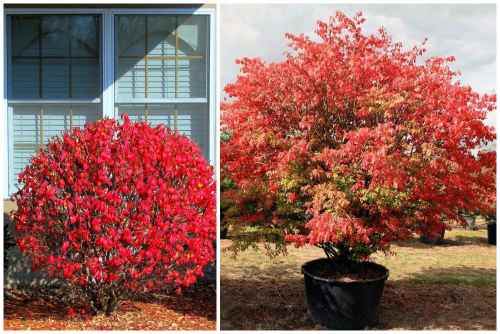
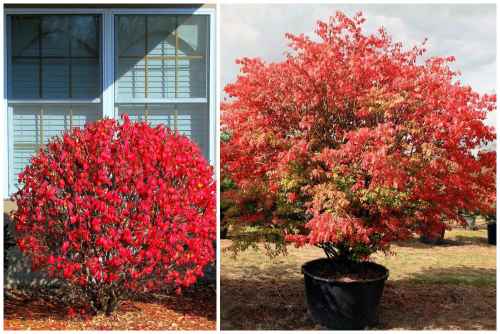
- European euonymus is a bushy tree up to 6 m tall, in which adult branches have a black tint, and young green shoots are cork growths. The leaves are large, leathery, turn red by autumn. When ripe, the fruit is dark pink with orange. The species tolerates frost, drought and polluted air well;
- Compact euonymus (dwarf) – no more than a meter in height. The variety is known for small (up to 4 cm long), leathery, light green leaves, the tips of which are sharply pointed and the edges are slightly bent down. The leaves underneath are olive or gray-green. There is almost no trunk, thin shoots. The plant is often shaped like a bonsai and used in interior design. It loves watering, shade, is often prone to pests, does not relate to heat;
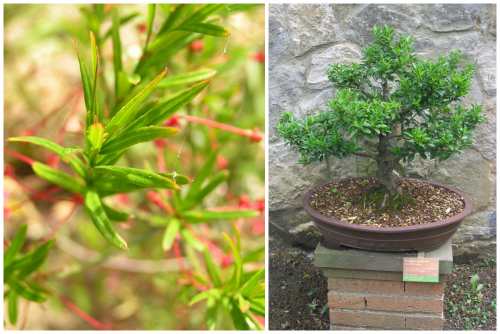
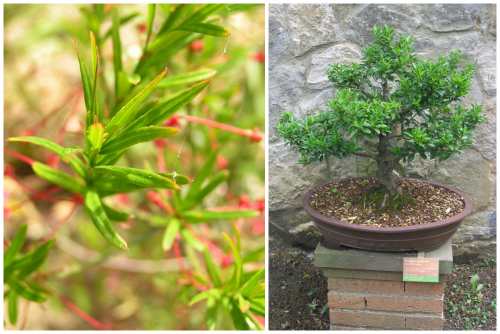
- Japanese euonymus is a well-branching shrub no more than 0,7 m tall and densely covered with green, less often light-bordered foliage. The fruits are in the form of bolls of a pale orange or pinkish hue. The tree needs constant feeding, moderate watering. It reacts hard to temperature changes and pest attacks. Strong heat can throw off foliage;
- Forchun’s euonymus is a creeping, low (1-1,2 m) evergreen plant, weakly branches. The leaves are small (about 5 cm long), shiny. At home, it is grown in hanging pots. Has bright pink fruits and dark orange seeds;
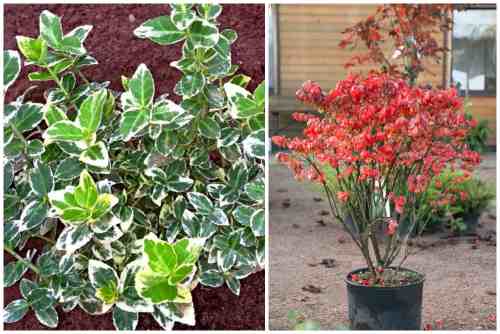
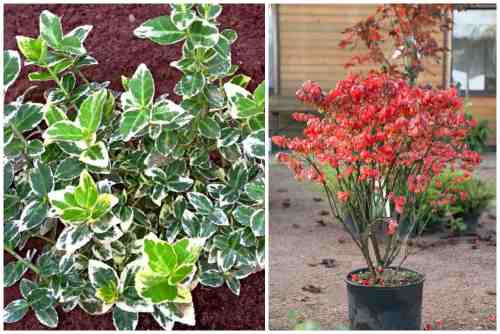
- Winged euonymus is a slow-growing, light-loving, deciduous shrub 1,5-2 m high with purple fruits. On the shoots, the ribs resemble wings. The leaves of a dark green color in the fall become crimson and bright scarlet;
- Emerald Gold euonymus is a selection hybrid, which is bred on the basis of Fortchun euonymus. Has variegated colored leaves up to 5 cm long. The representative of the flora is a ground cover, half a meter high, 1,5 m wide, without pruning, perfect for winter gardens and greenhouses. In autumn, the leaves take on a chocolate or reddish hue.


Euonymus seedlings can be bought in nurseries or online plant stores. The price will depend on the species, variety and height of the specimen. The cost of dwarf specimens 20-30 cm high is about 600-700 rubles, and 80-100 cm high can reach several thousand.
Varieties
There are many types of euonymus. Let’s consider the most common ones.
• Warty euonymus is a shrub about one and a half meters high, its shoots have numerous thickenings similar to warts. The shrub is slow-growing, unpretentious and frost-resistant.
• European spindle tree is a deciduous plant. It can be a shrub up to three meters high or a tree up to eight meters. The specific form depends on the type of plant and its growing conditions. Frost resistance is not high, but it can tolerate short-term drops in temperature to minus fifteen degrees.
• Fortchun’s euonymus is a creeping shrub, reaching a height of no more than half a meter. His homeland is China. The plant is decorative, has beautiful leaves. Fortune’s spindle tree is unpretentious, frost-hardy, but photophilous.
• Japanese spindle tree – a close relative of the previous species, but grows in Japan. In garden conditions, it can reach seven meters. The leaves are large and dense, with a light-colored border.
Euonymus are grown as garden ornamental plants. Of these species, only Japanese euonymus (Euonymus japonica) is suitable for indoor conditions. In addition to it, rooting euonymus is also grown as an indoor flower.
How to care for a plant
The euonymus is distinguished by its masculine harsh character. But, like any man, this bush cannot do without caring care. It includes watering and feeding, keeping the crown clean and trimming. Otherwise, your euonymus will become like a “neglected garden”.
Water and feed
From spring to autumn, euonymus loves to drink abundantly. He’s not too picky, but he still prefers more sophisticated drinks over chlorinated tap water. Rainy, thawed, filtered or at least lukewarm lukewarm water. To determine the frequency, monitor the condition of the topsoil. Once dry, water.
In the summer heat, the euonymus will be delighted to be sprayed, but the water should also be soft and warm. You can even wash the plant under a mild shower. Do not forget to monitor the purity of the leaves, the dusty euonymus not only looks bad, but also develops slowly.
With the arrival of autumn cold weather, water procedures must be stopped. It is enough only from time to time to wipe the foliage from dust with a damp cloth. An exception is euonymus left in warm, hot rooms, they will suffer from dry air, and spraying will be appropriate.
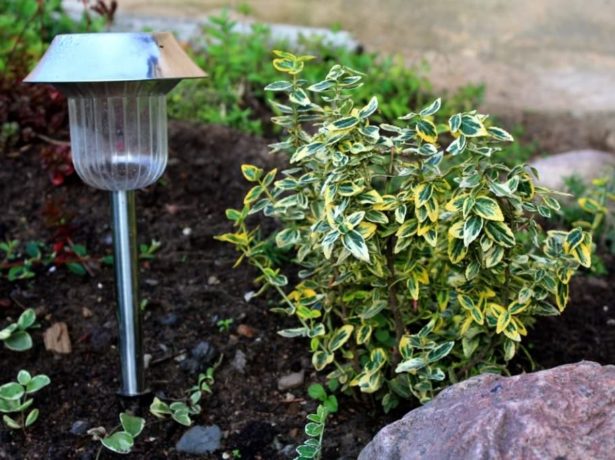
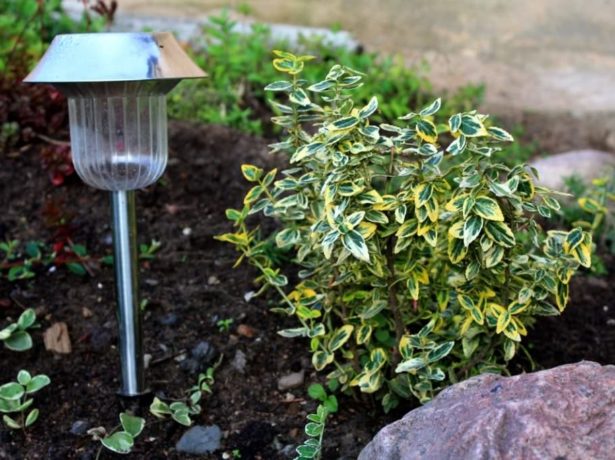
The euonymus bush must be kept clean
Watering in the fall and winter should be limited. When kept cold, minimize. If the euonymus hibernates on a glazed balcony, it is practically not watered.
During the active growth of shoots and leaves, in spring and summer, the euonymus will well accept feeding. You can alternate between organic and mineral complexes, adding them to irrigation water every two to three weeks. Any fertilizer is suitable for ornamental-leaved plants; euonymus is not very picky. In winter, when he is resting in the cool, food must be stopped.
Cutting the euonymus
When kept in a room, euonymus practically does not bloom, its main thing is the advantage of a beautiful crown. Therefore, it requires regular trimming and pinching. Moreover, sometimes a useful haircut needs to be done more often than once a year. Euonymus responds very well to pruning.
Usually the bush is cut at the very end of winter. First of all, thin, elongated twigs are removed. To increase bushiness, pinch the tops of the shoots. Thus, they stimulate the awakening of the dormant lateral buds. If you want to grow a tree, cut off the bottom shoots, leaving a bare stem and a lush “cap” on top.
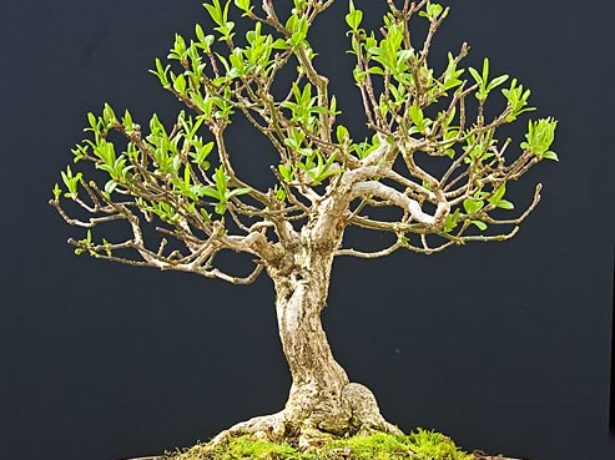
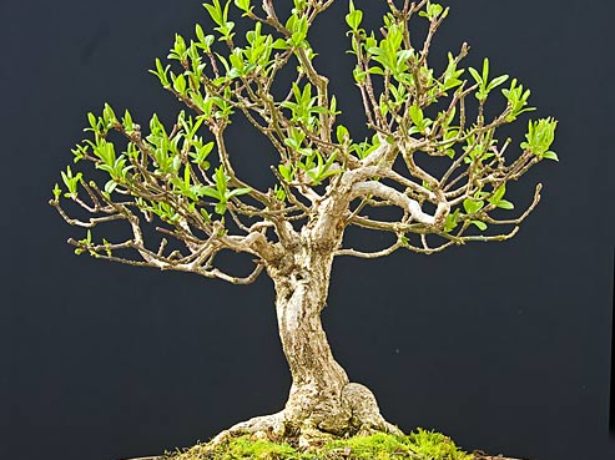
Euonymus lends itself well to formation
In the summer, pinch the shoots regularly to improve branching. Perform hygienic pruning in the fall. Cut out weak, dried branches, if necessary, update the shape of the crown.
Skillful florists form various shapes from the crown of the euonymus. It can be given a spherical or conical or cubic appearance. Plants from which bonsai are grown are pruned according to special rules.
We provide peace
The resting time for the spindle tree is winter. Deciduous forms, even when grown indoors in the fall, change the color of the foliage, and then completely or partially discard it. In evergreen varieties, the leaves should be preserved. But with excessively dry and warm air, they can also fall off. To stop leaf fall, you need to lower the temperature in the room.


Deciduous euonymus, even at home, do not change natural habits, in the fall they change the color of the foliage, and then shed it
Already in November, watering the plants is gradually reduced, feeding is canceled – during rest it is superfluous. And the lighting of the euonymus needs to be bright in winter.
Diseases and pests of euonymus
The motley leaves of the euonymus turned green. In euonymus, like in other plants, the reason is a lack of lighting. The light should be bright, and you can even put it in direct sunlight for a short time.
At the euonymus, the leaves turn yellow and fall. The main and most common cause is over-watering. The next stage is root decay. Adjust watering.
The tips of the euonymus leaves curl up and dry. This is most likely due to excess light. Also, the leaves can fade and fade.
Leaves fall off the spindle tree. The reason lies in the high temperature and insufficient air humidity in winter.
Spindle tree pests. The main guests are aphids. It is also affected by a spider mite.
Reproduction of euonymus
Domestic euonymus reproduces by cuttings, dividing the bush and seeds. The last method is the longest and most difficult, but sometimes it is the only option. For grafting and dividing, you need an adult euonymus bush.
Cuttings
In the middle or late summer, cut semi-lignified cuttings (7 cm each) of the euonymus, which is less than 5 years old, from the tops of the shoots. There should be one internode on the handle.
- Treat the cut of the cutting with phytohormone (Epin, Zircon or others).
- Fill the container with a mixture of peat and sand, moisten.
- Deepen the cuttings, tamp the substrate carefully, leaving no voids.
- Cover the seedlings with plastic wrap, bag or jar.
- Place in a bright and cool place.
- Moisten and air the plantings regularly.
- Rooting usually lasts 6-7 weeks. When new leaves begin to appear, transplant the cuttings into separate small (7–10 cm) pots with nutrient soil.
By dividing the bush
This method is combined with the transplant of a spindle tree, which is formed in the form of a bush. It is not suitable for tree-like specimens. Take an adult, healthy plant with a developed root system. This will handle the operation without any problems.
- Gently remove the plant from the pot, inspect the roots, marking the place of division.
- Use a sharp, clean knife to separate part of the rhizome with shoots. Sprinkle the cut with crushed coal.
- Cut the shoots on a separated plant two-thirds, plant it in a moistened soil for euonymus.
- Keep the detached plant cool and partial shade until it adapts.
Cuttings are an easy way to reproduce euonymus
Seeds
Indoor euonymus can also be grown from seeds purchased or collected from a garden bush. Their germination rate, according to the reviews of flower growers, is 60-70%.

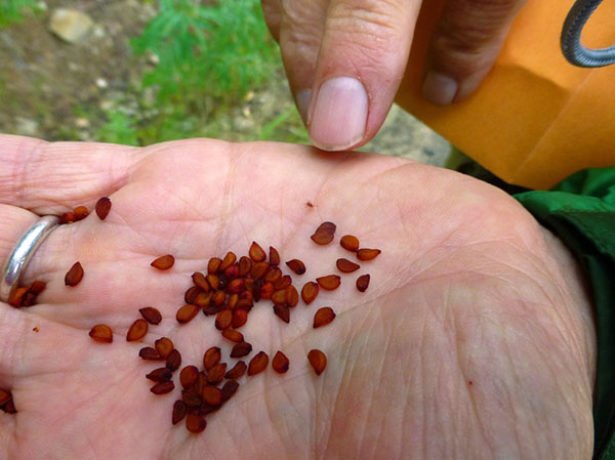
Euonymus seeds need to be stratified
- Stratify (cold season) before sowing. Wrap the seeds in a damp cloth or place in sand and refrigerate for three months (at a temperature of 0 3).
- Remove the seeds from the refrigerator and place in a lighted place, cover the top with foil to preserve moisture.
- Spread the warmed seeds on a light sterile substrate (peat and sand), sprinkle with a small layer of sand.
- Spray the plantings with a spray bottle with warm water.
- Close the container with foil or a transparent lid.
- The best result will be obtained by planting the seeds in a bottom heated greenhouse. Seed development requires a constant high temperature of 22–27 ° C.
- Once every 3-4 days, control the soil moisture, spray when dry, ventilate the crops.
- The sprouts hatch in one and a half to two months.
- When they have hardened and real leaves appear, cut the seedlings into separate cups. Protect young plants from drafts and cold air.
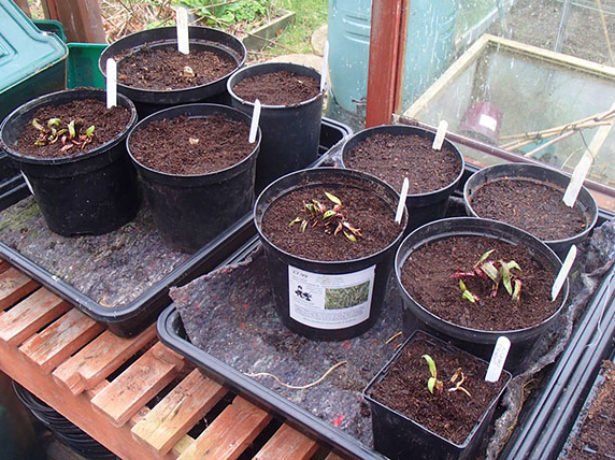
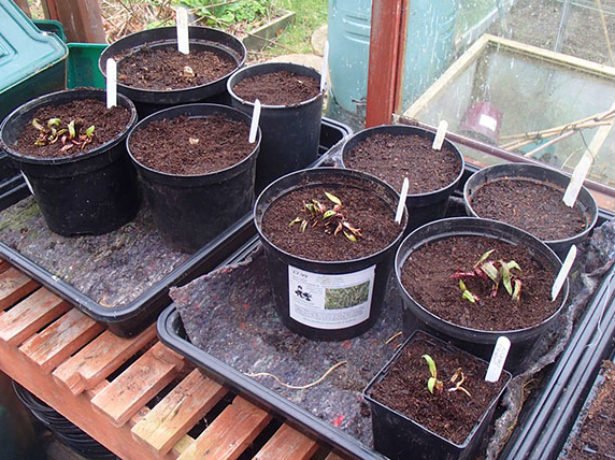
Sprouts of euonymus will appear no earlier than in a month and a half.
Euonymus has a real masculine character, he does not like greenhouse conditions. In addition, this plant is a protector. It is believed that growing near the house, or better in the house itself, euonymus protects its owners from harm. Other folk signs are also associated with the bright euonymus bush. They say that plants with yellow fruits attract money into the house, with red ones they lure love, and with orange ones they bring happiness. True or fiction, you can find out only by getting to know the euonymus better.
Treatment
The therapeutic properties of this poisonous plant were well known in ancient Greece and Rome. At home, alcoholic tinctures, decoctions and infusions are made from various parts of the plant.
During the period of fruit ripening, the plant is less dangerous and it is at this time that raw materials are collected. The healing effect is achieved due to many properties:
- Antihelminthic;
- Antiviral;
- Diuretic;
- Choleretic;
- Antiemetic;
- Laxative;
- Antispasmodic;
- Wound healing.
Therefore, this plant has proven itself in diseases of the nervous system (headaches); cardiovascular (hypertension); cutaneous (eczema, acne); gastrointestinal tract.
But still it is necessary to remember about the toxicity and try not to experiment, and it is better to consult a doctor.


Multifunctional shovel with 25 useful functions
The Brandcamp shovel is an indispensable tool for hunters, fishermen, summer residents, tourists, fans of extreme sports and outdoor activities. A great gift for any man!
Learn more
